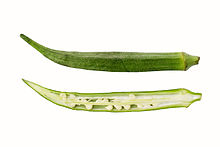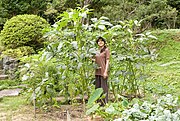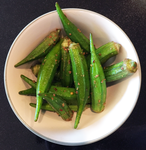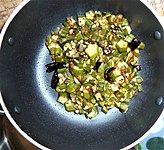Okra or Okro (US: /ˈoʊkrə/, UK: /ˈɒkrə/), Abelmoschus esculentus, known in many English-speaking countries as ladies' fingersor ochro, is a flowering plant in the mallow family. It is valued for its edible green seed pods. It is a good source of minerals, vitamins, antioxidants, and fiber.[2] The geographical origin of okra is disputed, with supporters of West African, Ethiopian, and South Asian origins. The plant is cultivated in tropical, subtropical, and warm temperate regions around the world and is a notable part of the cuisine of the Southern United Statesas well as Middle Eastern cuisine and Indian cuisine.[3]
Etymology
Origin and distribution
Okra is an allopolyploid of uncertain parentage. However, proposed parents include Abelmoschus ficulneus, A. tuberculatus and a reported "diploid" form of okra.[citation needed] Truly wild (as opposed to naturalised) populations are not known with certainty, and the species may be a cultigen.[citation needed]
The geographical origin of okra is disputed, with supporters of South Asian, Ethiopian and West African origins.[11] The Egyptians and Moors of the 12th and 13th centuries used the Arabic word for the plant, bamya, suggesting it had come into Egypt from Arabia, but earlier it was probably taken from Ethiopia to Arabia. The plant may have entered southwest Asia across the Red Sea or the Bab-el-Mandeb straight to the Arabian Peninsula, rather than north across the Sahara, or from India. One of the earliest European accounts is by a Spanish Moor who visited Egypt in 1216 and described the plant under cultivation by the locals who ate the tender, young pods with meal.[12] From Arabia, the plant spread around the shores of the Mediterranean Sea and eastward.[13]
The plant was introduced to the Americas by ships plying the Atlantic slave trade[14] by 1658, when its presence was recorded in Brazil. It was further documented in Surinamein 1686. Okra may have been introduced to southeastern North America from Africa in the early 18th century. By 1748, it was being grown as far north as Philadelphia.[15]Thomas Jefferson noted it was well established in Virginia by 1781. It was commonplace throughout the Southern United States by 1800, and the first mention of different cultivars was in 1806.[12]
Botany and cultivation
The species is a perennial, often cultivated as an annual in temperate climates, often growing to around 2 metres (6.6 ft) tall. As a member of the Malvaceae, it is related to such species as cotton, cocoa, and hibiscus. The leaves are 10–20 centimetres (3.9–7.9 in) long and broad, palmately lobed with 5–7 lobes. The flowers are 4–8 centimetres (1.6–3.1 in) in diameter, with five white to yellow petals, often with a red or purple spot at the base of each petal. The pollens are spherical with approximately 188 microns diameter. The fruit is a capsule up to 18 centimetres (7.1 in) long with pentagonal cross-section, containing numerous seeds.
Abelmoschus esculentus is cultivated throughout the tropical and warm temperate regions of the world for its fibrous fruits or pods containing round, white seeds. It is among the most heat- and drought-tolerant vegetable species in the world and will tolerate soils with heavy clay and intermittent moisture, but frost can damage the pods. In cultivation, the seeds are soaked overnight prior to planting to a depth of 1–2 centimetres (0.39–0.79 in). It prefers a soil temperature of at least 20 °C (68 °F) for germination, which occurs between six days (soaked seeds) and three weeks. As a tropical plant, it also requires a lot of sunlight, and it should also be cultivated in soil that has a pH between 5.8 and 7, ideally on the acidic side.[16] Seedlings require ample water. The seed pods rapidly become fibrous and woody and, to be edible as a vegetable, must be harvested when immature, usually within a week after pollination.[17] The first harvesting will typically be ready after about 2 months of plantation, and it will be approximately 2-3 inches long.[16]
The most common disease afflicting the okra plant is verticillium wilt, often causing a yellowing and wilting of the leaves. Other diseases include powdery mildew in dry tropical regions, leaf spots, yellow mosaic and root-knot nematodes. Resistance to yellow mosaic virus in A. esculentus was transferred through a cross with Abelmoschus manihotand resulted in a new variety called Parbhani kranti.[18]
Food and uses
The products of the plant are mucilaginous, resulting in the characteristic "goo" or slimewhen the seed pods are cooked; the mucilage contains soluble fiber.[19] One possible way to de-slime okra is to cook it with an acidic food, such as tomatoes, to render the mucilage less viscous.[20] Pods are cooked, pickled, eaten raw, or included in salads. Okra may be used in developing countries to mitigate malnutrition and alleviate food insecurity.[19]
Though classified as a fruit, Okra has often been utilized as a vegetable, both on its own and with other dishes and materials. When cooked, it takes many forms. Cutting and cooking okra in moisture will create a sticky juice that increases the thickness of soups and stews. Dried okra can also thicken sauces. It is sometimes used as an egg white substitute to increase richness of flavor. Other people might grind and roast the seeds as a non-caffeinated coffee substitute.[21]
In cuisine
In Cuba and Puerto Rico, the vegetable is referred to as quimbombó, and is used in dishes such as quimbombó guisado (stewed okra), a dish very similar to Southern gumbo.[22][23] It is also used in traditional dishes in the Dominican Republic, where it is called molondrón.[24]
Nutrition
Raw okra is 90% water, 2% protein, 7% carbohydrates and negligible in fat. In a 100 gram amount, raw okra is rich (20% or more of the Daily Value, DV) in dietary fiber, vitamin Cand vitamin K, with moderate contents of thiamin, folate and magnesium (table). Okra also provides iron, niacin, phosphorus, copper, and a rich source of antioxidants.[21]
Leaves and seeds
Young okra leaves may be cooked in a similar way to the greens of beets or dandelions, or in salads.[citation needed] Okra seeds may be roasted and ground to form a caffeine-free substitute for coffee.[12] When importation of coffee was disrupted by the American Civil War in 1861, the Austin State Gazette said, "An acre of okra will produce seed enough to furnish a plantation with coffee in every way equal to that imported from Rio."[25]
Greenish-yellow edible okra oil is pressed from okra seeds; it has a pleasant taste and odor, and is high in unsaturated fats such as oleic acid and linoleic acid.[26] The oil content of some varieties of the seed is about 40%. At 794 kg/ha, the yield was exceeded only by that of sunflower oil in one trial.[27] A 1920 study found that a sample contained 15% oil.[28] A 2009 study found okra oil suitable for use as a biofuel.[29]
Industrial uses
Bast fibre from the stem of the plant has industrial uses such as the reinforcement of polymer composites.[30] The mucilage produced by the okra plant can be used for the removal of turbidity from wastewater by virtue of its flocculant properties.[31][32]Having composition similar to a thick polysaccharide film, okra mucilage is under development as a biodegradable food packaging, as of 2018.[33]
Medical uses
There is ongoing research about the different uses of okra. One study explored the effect of okra extract on gestational diabetes mellitus in rats and its probable molecular mechanism. It was found to improve the blood sugar levels of pregnant rats with the disease.[34] Okra is also high in fiber—about eight medium-sized pods are estimated to contain 3 grams of fiber.[21] Another study found that okra increases fiber intake, promotes better glycemic control, and improves insulin sensitivity.[35] Okra seed extracts may have an antioxidant and anti-stress effect.[36] Foods such as okra that are high in fiber and antioxidants lower cholesterol levels, according to The American Heart Association.[37] Okra plants may also improve recovery times and fatigue levels.[38]


















Comments